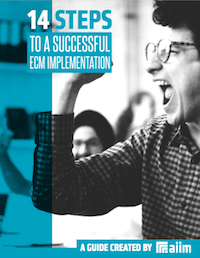The AIIM Blog
Keep your finger on the pulse of Intelligent Information Management with industry news, trends, and best practices.
We’ve all been there. We know that our information management technology is getting old, and it needs to be replaced. We can’t integrate to the newest artificial intelligence tools that could help improve the completeness and accuracy of the metadata, nor can we feel confident that we are managing records appropriately, and don’t even get me started on search. Despite these problems that we’re critically aware of, we sometimes find it difficult to get executive buy-in for the projects that are so desperately needed.
Share
AIIM Conference | AIIM on Air | Change Management
In 1936, Dale Carnegie's "How to Win Friends and Influence People" first published. Since then, it's become one of the best-selling books of all time with over 15 million copies sold! What makes this self-help book one of the most influential of our time?
Share

Making an ECM implementation successful requires planning and attention to detail. The best way to create the right solution is to identify organizational goals and priorities. Learn how to manage a successful implementation in our free guide.
AIIM Conference | Change Management
Enacting change is easier when you don’t have to go at it alone. In fact, a major factor in the success of organizational change comes down to internal buy-in with your co-workers. The more internal advocates you have on your side, the easier that positive change can spread quickly and efficiently. The old adage about there being ‘strength in numbers’ holds true when it comes to change management.
Share
AIIM on Air | Change Management
Over the course of several years, Kevin Craine has interviewed hundreds of folks in Information Management for the AIIM on Air podcast. There are a few questions Kevin loves to ask his guests: What’s your biggest challenge right now? What’s the one thing keeping you from truly innovating at your job? What is the single most significant barrier to digital transformation at your company?
Share
In my previous blog on change management, we examined the natural and inevitable cycle of change that people go through during times of change. We explored how resistance to change is often a more troubling problem than even the most complicated tangle of technology, and how project managers and systems integrators need to account for these human factors. Indeed, no matter how innovative new systems and technology are, or how thoughtfully we have put together our strategies, if people resist change and find ways to sabotage our efforts, it is unlikely that even the best technical implementation will have meaningful success.
Share
It is common to take great care in the selection and implementation of new technology. Interactions between hardware and software are cautiously investigated; operating systems and network connections are carefully tested, and uptime on critical systems is painstakingly protected. But one very influential factor that is often overlooked is the natural and emotional reactions of people when things change. If people resist change, find ways to sabotage your efforts or become angry or withdrawn, it is unlikely that even the best technology strategies will have meaningful success.
Share